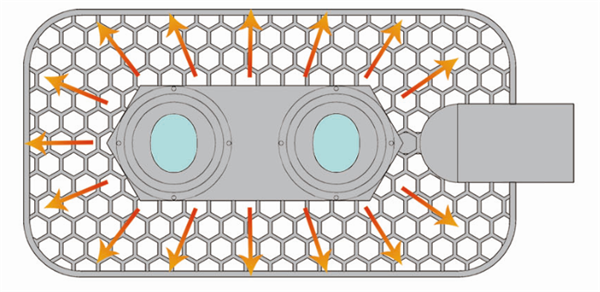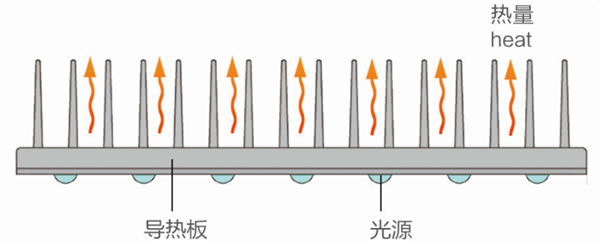Kaichuang Optoelectronics' new generation of honeycomb through-hole structure LED street light luminaires has accelerated the heat transfer and heat dissipation by changing the heat dissipation structure, and adopts a hexagonal through hole as the main structure, which not only stabilizes the structure but also ensures the luminaire's Kaichuang Optoelectronics. A new generation of honeycomb through-hole structure LED street light fixtures accelerates heat transfer and heat dissipation by changing the heat dissipation structure, and adopts a hexagonal through hole as a main structure, which not only stabilizes the structure, but also reduces the mechanical strength of the lamp. The weight of the luminaire, below we analyze the advantages of honeycomb through-hole LED luminaire from two aspects of heat transfer and heat dissipation.
First, the heat transfer of LED lamps
The heat transfer of the luminaire is determined by the luminaire material. The die-cast aluminum luminaire generally uses ADC12 as the die-casting material of the luminaire. The thermal conductivity is 96.2 (W/mK), its strength is high, the pressure resistance is particularly good, and the hot brittleness is small. It is very suitable for die-casting of die-casting parts. It adopts honeycomb through-hole structure. The heat generated by the intermediate light source can be quickly transmitted to the outside through the honeycomb frame. The closer to the source substrate, the thicker the wall thickness of the honeycomb, which plays the role of fast heat transfer. The thinner the wall thickness of the outer honeycomb, the lower the weight of the lamp and the higher cost performance of the lamp.

Heat transfer diagram of honeycomb through-hole structure lamps
Second, the heat dissipation of the LED lamps The heat dissipation of the lamps is determined by the contact area of ​​the radiators and the air and the flow rate of the air through the radiators. Traditionally, the fascia with a fin fin radiator structure has a closed structure and a relatively large number of dorsal fins, so that the air performance of the dorsal fin is not good, the cold air cannot be quickly replenished, and the hot air cannot be quickly dissipated, thereby greatly affecting The overall heat dissipation performance of the luminaire, the heat dissipation principle of the fin fin radiator is as shown in the figure:

Rear fin heat sink cooling diagram
Therefore, the honeycomb through-hole heat dissipation structure evolved from the back fin heat dissipation structure has its unique heat dissipation advantage. Due to the heat dissipation structure of the upper and lower through holes, hot air can be quickly transmitted through the through holes, which is more in line with the principle of air convection and accelerates the air. The flow rate of the radiator with the lamp effectively improves the heat dissipation performance of the lamp.

Honeycomb through-hole structure luminaire heat dissipation diagram
Secondly, due to the use of the honeycomb hexagonal through-hole structure, the contact area with the air per unit area of ​​the LED lamp radiator is increased, and the speed of heat transfer from the center to the outside of the lamp is accelerated, and the heat dissipation performance of the lamp is again improved.
After the actual test, in the case of the same lamp power, the third generation of LED lamps with honeycomb through-hole heat dissipation is more than 30% higher than that of LED lamps with traditional back fin heat dissipation, and the weight of the lamps is reduced by more than 30%. The performance of the product reduces the weight of the product and better meets the needs of the market.
The honeycomb hexagonal through-hole structure LED lamps independently developed by Kaichuang Optoelectronics have novel and unique design, leading the heat dissipation and light distribution technology, greatly extending the service life of the lamps, and obtaining more than ten technical patents, which are highly sought after by the LED lighting industry. The products are sold well in more than 40 countries and regions around the world. Kaichuang photoelectric cellular through-hole LED lamps can be used as LED lamp, LED landscape lamp, LED garden lamp, LED flood light, solar lamp, and are widely used in living quarters, urban roads, rural township roads, parks and gardens. Lighting places such as scenic spots, factories, workshops, home courtyards, squares, stadiums, exhibition halls, high pole lights, tunnels, etc.
Original link: (Analysis of how LED lamps quickly dissipate heat?)
Http://news.chinawj.com.cn Editor: (Hardware Business Network Information Center) http://news.chinawj.com.cn
The outermost layer of resistance screens is usually a soft screen that connects the internal contacts up and down by pressing. The inner layer contains the oxidized metal of the physical material, namely N-type oxide semiconductor (indium oxide), also known as indium oxide, with an optical transmittance of 80% and the upper and lower layers separated by the middle. ITO is the main material used in both resistive and capacitive touch screens. Their working surface is the ITO coating. The outer layer is pressed by fingertips or any object to make the surface film concave and deformed. According to the leading line number of screen, divide again have 4 line, 5 line and much line, threshold is low, cost is opposite cheap, advantage is not affected by dust, temperature, humidity. Disadvantages are also obvious, the outer screen film is easy to scratch, can not use sharp objects to touch the surface. In general, multi-touch control is not allowed, that is, it can only support a single point. If two or more contacts are pressed at the same time, they cannot be recognized and accurate coordinates can be found. To enlarge a picture on the resistance screen, you can only click "+" several times to make the picture be enlarged step by step. This is the basic technical principle of the resistance screen.
Control by pressure induction. When a finger touches the screen, the two conductive layers are in contact at the touch point and the resistance changes. A signal is generated in both X and Y directions and transmitted to the Touch Screen controller. The controller detects the contact and calculates the position of (X, Y), then works according to the simulated mouse mode. Resistive Touch screen is not afraid of dust, water and dirt, and can work in harsh environments. But because the outer layer of the composite film is made of plastic material, its anti-explosion property is poor, and its service life is affected to some extent.
The resistive touch screen is controlled by pressure induction. The surface layer is a layer of plastic and the bottom layer is a layer of glass, which can withstand the interference of harsh environmental factors. However, it has poor hand feel and light transmittance, so it is suitable for wearing gloves and occasions that cannot be touched directly by hand.
Resistive Touch Screen
Resistive Touchscreen,Resistive Screen,Resistive Touch,Resistive Touch Panel
Tonya Display Limited , https://www.tydisplay.com